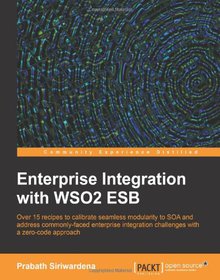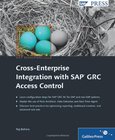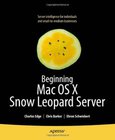Enterprise Integration with WSO2 ESB

Book Details:
| Publisher: | Packt Publishing |
| Series: | Packt |
| Author: | Prabath Siriwardena |
| Edition: | 1 |
| ISBN-10: | 1783280190 |
| ISBN-13: | 9781783280193 |
| Pages: | 92 |
| Published: | Oct 24 2013 |
| Posted: | Nov 19 2014 |
| Language: | English |
| Book format: | |
| Book size: | 1.16 MB |
Book Description:
Over 15 recipes to calibrate seamless modularity to SOA and address commonly-faced enterprise integration challenges with a zero-code approach Overview Learn how to implement the mostly-used Enterprise Integration Patterns with WSO2 ESB Discover how to integrate WSO2 ESB with FIX, HL7, and SAP gateways Understand the key concepts behind WSO2 ESB, and find optimized recommendations for deploying WSO2 ESB in a production setup In Detail The Enterprise Service Bus (ESB) serves as a key component in most of the enterprise grade deployments. In most cases, the ESB removes point-to-point dependencies in your system to build a highly-scalable, loosely-coupled solution. ESB is a key ingredient to build an SOA infrastructure, but it's not a must. Even with an ESB, if industry best practices and patterns are not followed, users will end up in a mess. This book will teach you the essentials to get started with WSO2 ESB and solve the most commonly-faced integration problems. The book starts by explaining the need for an ESB and the problems it solves. It will cover the most widely-used enterprise integration patterns, including Content Based Router, Dynamic Router, Splitter, Aggregator, Scatter & Gather, Publish & Subscribe, Detour, Service Chaining, Content Enricher and Message Broker. Learn how WSO2 ESB can bring third-party business messaging systems such as SAP, FIX, and HL7 into the SOA world, as well as how to integrate the Twitter connector into your business messaging flow. What you will learn from this book Implement commonly used Enterprise Integration Patterns with WSO2 ESB Integrate WSO2 ESB with Apache Active MQ and Apache Qpid Message Brokers Connect your SAP system to a better or wider SOA infrastructure Integrate your business messaging systems, such as FIX and HL7, with WSO2 ESB Connect to Twitter from WSO2 ESB Deploy WSO2 ESB in a production setup Approach Providing background on the when and why of the topic, then diving into practical, instruction-based examples called recipes, where each recipe will explain how to address a given challenge in enterprise integration. Who this book is written for If you are an architect or a developer, keen on building solutions to solve enterprise integration problems, this is the book for you! Understanding of SOA design concepts, SOAP, REST, and related messaging systems is important. However, you are not expected to be an advanced user of WSO2 ESB.
Download Link:
Related Books:
Enterprise Integration with Ruby
Typical enterprises use dozens, hundreds, and sometimes even thousands of applications, components, services, and databases. Many of them are custom built in-house or by third parties, some are bought, others are based on open source projects, and the origin of a few--usually the most critical ones--is completely unknown. A lot of applications are very old, some are fairly new, and seemingly no two of them were written using the same tools. They run on heterogeneous operating systems and hardware, use databases and messaging systems from various vendors, and were written in different programming languages. See how to glue these disparate applications together using popular technologies such as: LDAP, Oracle, and MySQL XML Documents and DTDs Sockets, ...
Cross-Enterprise Integration with SAP GRC Access Control
This book provides cross-enterprise configuration instructions and best practices for SAP GRC Access Control implementations in companies with multi-system architectures. The author provides the implementation strategies, configuration steps, and best practices necessary to implement and manage a global access control, risk remediation, and compliance framework across a multi-system landscape, including non-SAP and legacy systems. Readers discover how to use Offline Risk Analysis, Real Time Analysis, and Management Update Report to manage risk analysis across the enterprise and quickly come to understand how to build and manage a rule matrix for a multi-system enterprise using the Real Time Agent (RTA), as well as the functional use of the Rule Arch...
Beginning Mac OS X Snow Leopard Server
From Solo Install to Enterprise Integration
This book is intended for those who need to get things done with Mac OS X Server 10.6. As such, you can use this book two ways. Those new to Mac OS X Server can read straight through the entire book, and by the end should feel competent to administer any Mac server thrown their way. For those with some knowledge of Mac OS X Server, or perhaps a thorough knowledge of other Unix-based servers, the book is arranged by tasks so that you can either start reading at any point, skipping material you already know, or pick and choose the chapters youll find most helpful to your own work or system needs. This task-oriented approach also makes the book useful as a general reference for all aspects of Mac OS X Server. Throughout the book, special emphasis is giv...
2007 - 2021 © eBooks-IT.org



